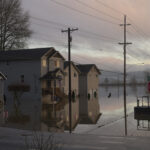New York regulators have endorsed Consolidated Edison’s plan to swallow all the costs of a deadly explosion in midtown Manhattan and closed their investigation into whether the utility mismanaged its steam system.
Under a settlement the New York Public Service Commission approved Wednesday, Con Ed agreed not to pass the cost of repairs and related expenses — such as higher insurance premiums — along to customers by raising their utility bills. The deal also closes the door on a possible state lawsuit against the utility.
State regulators estimate Con Ed’s total costs from the explosion at about $37 million.
William Bouteiller, a PSC administrative law judge who worked on the settlement, said Con Ed also agreed to make a “public statement of regret” about the July 2007 blast.
“The public interest is well-served in approving the settlement since it precludes Con Edison from recovering from ratepayers its direct and indirect costs for the steam pipe rupture,” said Garry Brown, the PSC’s chairman.
“In addition, the settlement significantly promotes the safety of the steam system,” Brown said.
As part of the settlement, Con Edison also agreed to reimburse customers who were locked out of their businesses in the area of the explosion.
In a statement released late Wednesday, Con Edison said it “sincerely regrets the incident and the substantial and profound impacts the incident had on our customers and the public.”
The underground explosion unleashed a geyser of steam and mud and left a huge crater at 41st Street and Lexington Avenue.
One woman died of a heart attack running from the scene. Two others were seriously burned when the tow truck they were in fell into the crater. Many others were injured by flying debris.
The settlement allows Con Ed to avoid a state lawsuit. But the company still faces at least 89 separate suits related to the blast.
Investigations found the explosion was caused by sealant from a leaky steam pipe that clogged an underground pressure relief valve. The company has since changed its inspection and repair procedures.
Was this article valuable?
Here are more articles you may enjoy.

 ‘Door Knocker’ Roofers Were Everywhere. NC Farm Bureau Saw an Opportunity
‘Door Knocker’ Roofers Were Everywhere. NC Farm Bureau Saw an Opportunity  Rare Weather Warning Issued as Strong Gusts Fuel Colorado Wildfire Threats
Rare Weather Warning Issued as Strong Gusts Fuel Colorado Wildfire Threats  Twice Injured Firefighter Loses Second Workers’ Compensation Claim
Twice Injured Firefighter Loses Second Workers’ Compensation Claim  Pacific Northwest Braces for Even More Flooding Rain This Week
Pacific Northwest Braces for Even More Flooding Rain This Week 